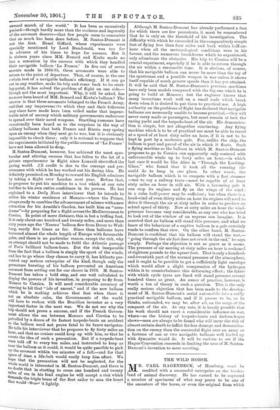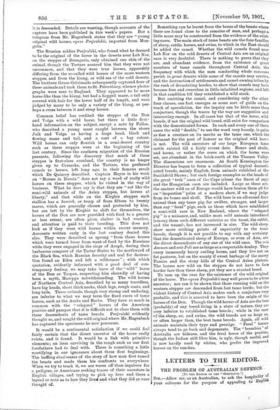THE WILD HORSE.
MR. CARL HAG-ENBECK, of Hamburg, must be credited with a successful enterprise on the border- land of animal discovery. He has caused to be captured a number of - specimens ' of what may prove to be one of the ancestors of the horse, or even the original fiom which
it is descended. Details are wanting, though accounts of the capture have been published in this week's papers. But a telegram from Mr. Hagenbeck states that they are " young
original wild horses, equus Prejvalskii, imported from Mon- golia?,
The Russian soldier Prejvalski, who found what he deemed to be the original of the horse in the deserts near Lob Nor, on the steppes of Dsungaria, only obtained one skin of the animal, though the Tartars assured him that they were not uncommon, and that they were true horses, apparently differing from the so-called wild horses of the more western steppes, and from the kiang, or wild ass of the cold deserts. The brothers Grum-Grizimailo subsequently captured four of these animals and took them to St. Petersburg, whence photo- graphs were sent to England. They appeared to be more horse-like than the kiang, but had a hogged mane, a tail only covered with hair for the lower half of its length, and were judged by many to be only a variety of the kiang, or per- haps a cross between it and stray horses.
Common belief has credited the steppes of the Don and Volga with a wild horse, but there is little first- hand information on the subject, except a note by Pallas, who described a young mare caught between the rivers Juik and Volga as having a large head, black and flowing mane and tail, and a coat of a bay colour. Wild horses can only flourish in a semi-desert country such as these steppes were at the beginning of the last century. Since the southern migration of the Russian peasants, following the discovery that much of these steppes is first-class cornland, the country is no longer given np to Cossacks, and the Tartars, who preferred camels to horses, left long ago, in their famous revolt which De Quince), described. Captain Hayes in his work on " Horses in Russia" does not say a word of really wild horses on these steppes, which he visited in the way of business. What he does say is that they are "not like the semi-wild animals of the Asian steppes, but horses at liberty," and that while on the Kirghiz steppes each stallion has a kossiak, or troop of from fifteen to twenty mares, which are generally chosen and protected by him, but are left by the Kirghiz to shift for themselves, the horses of the Don are now provided with food to a greater or less extent, are often given shelter in bad weather, and attention is paid to their breeding. This does not look as if they were wild horses within recent memory. Accounts written early in the last century denied this also. They were described as sprung " from those horses which were turned loose from want of food by the Russians while they were engaged in the siege of Azoph, during their barbarous conquest of the Tartar States to the northward of the Black Sea, which Russian ferocity and zeal for destruc- tion found an Eden and left a wilderness " ; with which quotation, evidently informed with a good deal of con- temporary feeling, we may take leave of the " wild " horse of the Don or Tarpan, suspecting him shrewdly of having
been a myth, Mazeppa notwithstanding. The wild horses of Northern Central Asia, described by so many travellers, have big heads, short thick necks, thick legs, rough coats, and long tails. These animals, though very strong and enduring, are inferior to what we may term the fixed races of tame horses, such as the Arabs and Barbs. They have so much in common with the " relapsed " horses of the American prairies and pampas that it is difficult not to class them with these descendants of tame breeds. Prejvalski evidently thought so, and sought the wild original where Mr. Hagenbeck has captured the specimens he now possesses.
It would be a sentimental satisfaction if we could feel fairly certain that the direct ancestor of the horse really exists, and is found. It would be a link with primitive elements ; an item surviving in the rough such as our first forefathers had to deal with. There is something a little mortifying in our ignorance about these first beginnings. The baffling elusiveness of the story of how man first tamed the beasts and made them his confronts us everywhere. When we try to track it, we are worse off than inquirers for a pedigree, or Americans seeking traces of their ancestors in English villages, and trying to pick up here and there a legend or note as to how they Rya and what they did or-were thought of.
Something can be learnt from the bones of the beasts where these are found -close to the remains of man, and perhaps a little more may be constructed from the evidence of the exist.
ing races. The main stock of tame beasts are the four families of sheep, cattle, horses, and swine, to which in the East should be added the camel. Whether the wild camels found near Lob Nor on the cold deserts of Central Asia are an original race is very doubtful. There is nothing to prove that they are, and abundant evidence, from the existence of great numbers of tame camels throughout Central Asia, the ' frequency with which the men conducting whole caravans perish in great deserts while some of the camels may survive, and the destruction of settlements and camel-owning tribes by the rush of devastating hordes, to show that camels may have become free and ownerless in little-inhabited regions, and left in that condition till they established a wild stock.
But omitting the camel, and considering only the other four classes, one fact emerges as some sort of guide on the track of speculation, for the inquiry can be little more than conjecture, though the traces by the way are suggestive and interesting enough. In all cases but that of the horse, wild breeds, if not the original wild breed, still exist for comparison with the domesticated forms. In each and every one of these cases the wild "double," to use the word very loosely, is quite as fine a creature on its merits as the tame one, which the claimant for the post of honour as the original wild horse is not. The wild ancestors of our large European tame cattle existed till a fairly recent date. Bones and skulls, and horns, or rather the cores on which the horns were set, are abundant in the brick-earth of the Thames Valley. The dimensions are enormous. At South Kensington the Director has begun to form a collection of typical domesti- cated breeds, mainly English, from animals exhibited at the Smithfield Shows ; but such foreign examples as the heads of the great " trek " oxen of the Cape (about the finest of any) and the Hungarian oxen are included. Large as these are, the ancient wild ox of Europe would have beaten them all for an " inspection" prize at a modern show, if we may judge from its bones and skull. The wild boar is an all-round finer animal than any tame pig, far swifter, stronger, and larger than any " feral" pigs, such as those which have established a semi-wild race in New Zealand, where the " relapsed pig" is a nuisance, and, unlike most wild animals introduced (among them such different varieties as the trout, the rabbit, and the weasel), has not increased in size. The wild sheep show more striking points of superiority to the tame breeds, though it is not possible to say with any certainty that the domesticated sheep of Europe, or even of Asia, are the direct descendants of any one of the wild ones. The oris Ammon and atria Poli are as large as a respectable donkey. They carry immensely heavy curling horns, and they live not on fat pastures, but on the scanty if sweet herbage of the snowy Pamirs and the stony bills of the Central Asian plateau. The horses now wild on the steppes do not have to face harder fare than these sheep, yet they are a stunted breed.
To sum up the case for the existence of the wild original of the horse. The equus Prejvalskii may well prove to be a true ancestor; nor can it be shown that those running wild on the western steppes are descended from lost tame herds ; but the violent history of Central Asia makes such a conjecture very probable, and this is asserted to have been the origin of the horses of the Don. Though the wild horses of Asia are the best (probably) of any breed living in a state of nature, they are very inferior to established tame breeds; while in the case of the sheep, ox, and swine, the wild breeds are as large as, or often larger than, the best tame breeds. Again, all wild animals maintain their type and prestige. " Feral " horses always tend to go back and degenerate. The. " brombies " of Australia are hideous, and the feral horse of the prairies, though the Indian still likes him, is ugly, though useful, and is now hardly used by whites, who prefer the improved horses on the ranches.















































 Previous page
Previous page